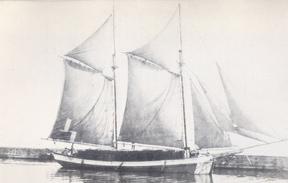Jon Paul’s Maritime Diaries
- Share
- Tweet
- Pin
- Share

A scow schooner being loaded with lumber. Notice the blunt bow typical of the boxy construction of a scow schooner.
The last issue left off with the Farrand H. Williams being libeled by the U.S. Marshall for unpaid seamen’s wages of $575, and the ship was sold at Manitowoc in January of 1885 for $1,500. Captain Francis Porter Williams ran into a cash flow problem; and although he did at least three successful salvage jobs with the vessel and it was a good lumber hauler, there was nothing he could do to save his beleaguered craft. Captain Williams, who still received nearly $1,000 from the sale and was still owed money from the recovered pig iron from the Nilsson, would go on to buy steamers Grace Williams and St. Maries.
C.C. Barnes from Manitowoc purchased the Farrand H. Williams with Captain Anton Hanson as master. Captain Hanson was born in Laurvig, Norway in 1837, and in 1853, he came to America with his parents Soren and Matilda. The family settled in Ephraim where Soren operated a busy wood dock on the west side of Eagle Harbor. Captain Hanson would run the Williams from northern ports to load lumber for Milwaukee and Chicago markets, often loading at his father’s dock in Ephraim.
In late September of 1888 he was loading lumber in Sister Bay at the Roeser’s pier. Gale winds started to blow from the northwest and than veered to the northeast smashing the scow schooner into the pier, which was badly wrecked. The crew and some of the dock employees stood duty all night thinking the vessel could be lost at any minute. The Williams labored heavily but made it through the night in relatively good shape. She left for Milwaukee a few days later only to be caught by another storm and had to seek shelter in Eagle Harbor, where she waited the storm out and eventually made it to Milwaukee with her load of wood.

The scow schooner Libbie Carter loaded with shingles. With little or no curved timbers used in the construction of a scow schooner, they could be built cheaply, in very little time and by semi-skilled labor.
The following year the Williams would have a similar experience at Sister Bay. The Williams along with the schooner Arctic were loading lumber at the Roeser’s pier in early December of 1889. The vessels finished loading and with the weather looking bad decided to ride it out behind Sister Island, figuring it would blow out of the northeast. They dropped an anchor, and the wind turned and blew from the north, northwest. They now dropped both anchors and paid out all of the cable. They rode the storm out all night and when day broke were surprised to find they were at the south side of Sister Bay having dragged their anchors over a mile. The Arctic was near by and when the gale increased in strength the two vessels decided to abandon ship. The ice on the decks of the Williams was so thick that the decks were almost even with the water. The yawl boat was launched earlier but was half full of ice. The brave Captain Hanson got into the boat and chiseled out the ice for a half an hour before the three remaining crew joined him and made it to shore in the heavy surf where a crowd of people gathered and helped them in. The two vessels managed to make it through the night and the storm subsided. A messenger was dispatched to Fish Creek for the tug Hill, but she was in Menominee. A few days later she reached Sister Bay and towed the Williams to Horseshoe Island were the crew dislodged the ice from the ship, and she proceeded to Milwaukee. It was one of the most harrowing experiences of Captain Hanson’s long career at sea.
The Williams left Milwaukee for Jacksonport shortly after Christmas in 1892. Near Kewaunee she ran into bad weather and sought refuge in that harbor. She was stuck all winter, and finally in April, the Williams made it to Sturgeon Bay for a load of wood.
The following December, Captain Hanson took the Williams and his family to Horseshoe Island where he dropped anchor and made the Williams their home for the winter.

A scow schooner tacking in the wind, because of the blunt bow and boxy construction the scows would answer hard to helm.
In the spring of 1894 Captain Hanson purchased the Williams from C.C. Barnes for $200 and all debts and liabilities, which amassed to an additional $150. Captain Hanson would sail the Farrand H. Williams for another six years – always being the last ship in for the winter and the first one to leave. He would sell his beloved ship in October of 1899 to Captain Christian Peterson who would sail her until September 16, 1900 when she stranded and became a total loss.
Whether the scow schooner south of the lighthouse near Eagle Bluff is the Farrand H. Williams is hard to say, the scow schooner Whiskey Pete was also wrecked in the area in 1885.
